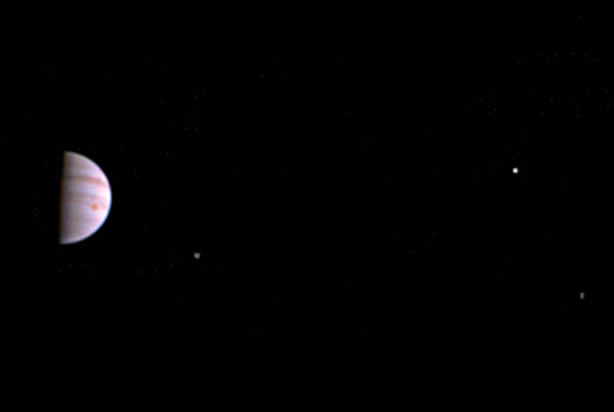Six days after performing what one of the engineers who worked on the Philae probe called “a suicide space mission like no other,” Juno delivered the first image of the gas giant. While it’s neither superficially impressive, as Scott Bolton of the Southwest Research Institute — one of NASA’s partners in this mission — noted, “this scene from JunoCam indicates it survived its first pass through Jupiter’s extreme radiation environment without any degradation and is ready to take on Jupiter.”
Although the first high-resolution images won’t be taken until Juno makes a close pass of the planet on August 27, it’s worth noting what NASA and its partners have already accomplished in safely placing the probe in its 53-day elliptical orbit around the planet. As Bolton noted, Jupiter’s “a monster, it’s unforgiving, it’s relentless. It’s spinning around so fast. Its gravity is like a giant sling shot, slinging rocks, dust, electrons, whole comets — anything that gets close to it becomes its weapon.”
Demonstrating that such pinpoint maneuvering could be accomplished by a deep space probe with the assistance of the Earth-based Deep Space Network is vital to the success of any future mission to the outer region of the solar system — or to any manned mission to Mars.
While there is currently a lull in NASA missions due to the 2013 budgetary sequestration, which hamstrung NASA’s ability to plan future mission, Congress recently ordered the organization to design and execute a mission to Jupiter’s moon Europa. Moreover, it demanded NASA do so aboard a rocket that NASA’s director of planetary science, Jim Green, characterized as “the most powerful rocket humans have ever built [and the one that] will take astronauts to Mars.”
As he told NPR earlier this month, “it has an enormous power and capability. Human exploration will be developing these and they want to stay proficient, and so launching unmanned probes, particularly to the outer part of our solar system, might indeed be a good thing for everyone.”
So while the Juno mission will focus its attention on the composition of Jupiter and what that tells us about the formation of the solar system, it will also teach NASA engineers how to navigate through some of the harshest environments in space, ones in which intense radiation and high-velocity debris represent a constant threat — which is, of course, a prerequisite to any manned exploration of a planet beyond our own moon.
Similarly, while the congressionally mandated mission to Europa will focus on understanding its oceans and, if possible, sampling them, the rocket that will take the orbiter and lander there will figuratively piggy-back on the technology that brought Juno safely into Jupiter’s orbit, and literally on the very rocket that would take mankind to Mars.
Meaning that slightly blurry image of Jupiter might not impress on first blush, but it represents nothing short of the future of manned space exploration.

